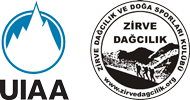| GERİ | Paylaş | 774 |
Ascending the rope in self-rescue: take care when approaching the anchor
Bu makaleyi çevirerek ülkemizde ki sınırlı kaynakları geliştirmek adına bize yardımcı olabilirsin. Yapacağınız çeviriler iletişim bilgilerinizle beraber yayınlanacaktır.
Bize ulaşın lütfen.
Warnings
- Read the technical notice before viewing the following techniques.
- It is important to fully understand the information provided in the technical notice before using this complementary information
- Mastering these techniques requires training.
- Consult a professional before attempting to perform these techniques on your own.
When ascending rope, it is common to climb the wall instead of the rope when approaching the anchor.
At this moment, even if it is possible to make some climbing moves, the rope must always remain taut between the anchor and the ascenders to limit the potential fall distance.
If the climber neglects taking up slack, just a single step can significantly increase the fall factor. The consequences of a slip can be severe, as arriving at the anchor is a time when the climber feels more or less "out of the woods."



Fall tests in a self-rescue situation (ascending rope) close to the anchor.
Warning: second ascender and/or self-belay not shown.
Fall of 0.5 m, approaching the anchor

| Rope | Impact force |
| 8 mm low stretch kernmantel | 4.3 kN |
| 8.1 mm dynamic | 3.4 kN |
| Rope | Impact force |
| 10.5 mm low stretch kernmantel | 4.3 kN |
Fall of 1 m at anchor level

| Rope | Impact force | ||
| 8 mm low stretch kernmantel | 5.4 kN |  |
Cut sheath |
| 8.1 mm dynamic | 4.2 kN |  |
Damaged sheath |
| Rope | Impact force |
| 10.5 mm low stretch kernmantel | 5.5 kN |
Warning:
When approaching the belay station, one step is enough to worsen the consequences of a fall. In this example, 50 cm makes the difference between an "average" and a "severe" fall.
Kanala abone olmak için
Hedef 200 eğitim videosu
Tırmanış konusunda her hafta yeni bir bilgi için abone olun

